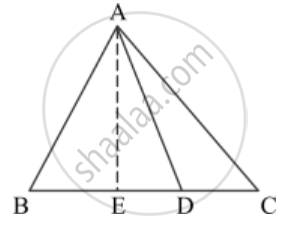Advertisements
Advertisements
प्रश्न
A point D is on the side BC of an equilateral triangle ABC such that\[DC = \frac{1}{4}BC\]. Prove that AD2 = 13 CD2.
उत्तर
We are given ABC is an equilateral triangle with `CD = 1/2 BC`
We have to prove `AD^2 = 13DC^2`
Draw `AE ⊥ BC`
In Δ AEB and ΔAED we have `AB =AC`
`∠ AEB = ∠ AEC = 90^o `
`AE = AE`
So by right side criterion of similarity we have

Thus we have
`DC =1/4BC and BE =EC = 1/2 BC`
Since `∠ C= 60^o` therefore
`AD^2 =AC^2+DC^2 - 2DC xxEC`
`AD^2 = AC^2(1/4BC)^2-2xx1/4BCxx1/2BC`
`AS^2=AC^2+1/16BC^2-2xx1/2BCxx1/2BC`
`AD^2=AC^2+1/16BC^2-BC^2`
We know that AB = BC = AC
`AD^2=BC^2+1/16BC^2-BC^2`
`AD^2=(16BC^2+1BC^2-4BC^2)/16`
`AD^2=13/16BC^2`
We know that `DC = 1/4 BC`
`4DC=BC`
Substitute `4DC=BC` in `AD^2 =13/16BC^2 ` we get
`AD^2 = 13/16xx(4DC)^2`
`AD^2 = 13/16xx16DC^2`
`AD^2 = 13/16xx16xxDC^2`
`AD^2=13DC^2`
Hence we have proved that `AD^2 = 13 DC^2`
APPEARS IN
संबंधित प्रश्न
Diagonals AC and BD of a trapezium ABCD with AB || DC intersect each other at the point O. Using similarity criterion for two triangles, show that `"OA"/"OC"="OB"/"OD"`.
The diagonals of quadrilateral ABCD intersect at O. Prove that
`[A(∆"ACB")]/[A(∆"ACD")] = "BO"/"DO"`
In ∆ABC, ∠C is an obtuse angle. AD ⊥ BC and AB2 = AC2 + 3 BC2. Prove that BC = CD.
In a quadrilateral ABCD, given that ∠A + ∠D = 90°. Prove that AC2 + BD2 = AD2 + BC2.
In ∆ABC, given that AB = AC and BD ⊥ AC. Prove that BC2 = 2 AC. CD
State Pythagoras theorem and its converse.
A man goes 24 m due west and then 7 m due north. How far is he from the starting point?
In an equilateral triangle ABC if AD ⊥ BC, then
If ABC is an isosceles triangle and D is a point of BC such that AD ⊥ BC, then
∆ABC is a right triangle right-angled at A and AD ⊥ BC. Then, \[\frac{BD}{DC} =\]
